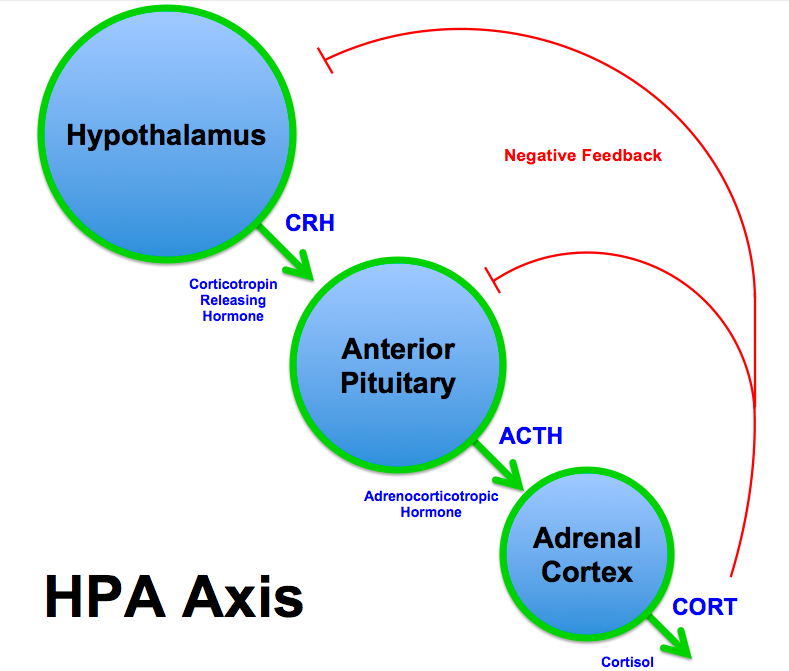Addison's disease pathophysiology: Difference between revisions
Aditya Ganti (talk | contribs) |
Aditya Ganti (talk | contribs) |
||
| Line 45: | Line 45: | ||
{| class="wikitable" | {| class="wikitable" | ||
! | !Causes | ||
! | !Definition | ||
! | !Pathophysiology | ||
|- | |- | ||
|Adrenal dysgenesis | |Adrenal dysgenesis | ||
| | |Gland has not formed adequately during development | ||
| | | | ||
* [[genetic mutation|Mutations]] to the ''SF1'' [[transcription factor]], [[X-linked adrenal hypoplasia congenita|congenital adrenal hypoplasia]] (AHC) due to ''DAX-1'' gene mutations | * [[genetic mutation|Mutations]] to the ''SF1'' [[transcription factor]], [[X-linked adrenal hypoplasia congenita|congenital adrenal hypoplasia]] (AHC) due to ''DAX-1'' gene mutations | ||
* Mutations to the [[ACTH receptor]] gene (or related genes, such as in the [[Triple A syndrome|Triple A]] or Allgrove syndrome) | * Mutations to the [[ACTH receptor]] gene (or related genes, such as in the [[Triple A syndrome|Triple A]] or Allgrove syndrome) | ||
* ''DAX-1'' mutations may cluster in a syndrome with [[glycerol kinase]] deficiency with a number of other symptoms when ''DAX-1'' is deleted together with a number of other genes. | * ''DAX-1'' mutations may cluster in a syndrome with [[glycerol kinase]] deficiency with a number of other symptoms when ''DAX-1'' is deleted together with a number of other genes. | ||
|- | |- | ||
|Impaired steroidogenesis | |Impaired steroidogenesis | ||
| Line 67: | Line 65: | ||
* Of the synthesis problems, [[congenital adrenal hyperplasia]] is the most common (in various forms: [[Congenital adrenal hyperplasia due to 21-hydroxylase deficiency|21-hydroxylase]], [[Congenital adrenal hyperplasia due to 17 alpha-hydroxylase deficiency|17α-hydroxylase]], [[Congenital adrenal hyperplasia due to 11β-hydroxylase deficiency|11β-hydroxylase]], and [[Congenital adrenal hyperplasia due to 3 beta-hydroxysteroid dehydrogenase deficiency|3β-hydroxysteroid dehydrogenase]]). | * Of the synthesis problems, [[congenital adrenal hyperplasia]] is the most common (in various forms: [[Congenital adrenal hyperplasia due to 21-hydroxylase deficiency|21-hydroxylase]], [[Congenital adrenal hyperplasia due to 17 alpha-hydroxylase deficiency|17α-hydroxylase]], [[Congenital adrenal hyperplasia due to 11β-hydroxylase deficiency|11β-hydroxylase]], and [[Congenital adrenal hyperplasia due to 3 beta-hydroxysteroid dehydrogenase deficiency|3β-hydroxysteroid dehydrogenase]]). | ||
* [[Lipoid congenital adrenal hyperplasia|Lipod CAH]] is due to a deficiency of [[Steroidogenic acute regulatory protein|StAR]] and [[mitochondrial DNA]] mutations. | * [[Lipoid congenital adrenal hyperplasia|Lipod CAH]] is due to a deficiency of [[Steroidogenic acute regulatory protein|StAR]] and [[mitochondrial DNA]] mutations. | ||
|- | |- | ||
|Adrenal destruction | |Adrenal destruction | ||
| Line 76: | Line 73: | ||
*Adrenal destruction is also a feature of [[adrenoleukodystrophy]] (ALD), and when the adrenal glands are involved in [[metastasis]] (seeding of [[cancer]] cells from elsewhere in the body), [[hemorrhage]] (e.g. in [[Waterhouse-Friderichsen syndrome]] or [[antiphospholipid syndrome]]), particular [[infection]]s ([[tuberculosis]], [[histoplasmosis]], [[coccidioidomycosis]]), and deposition of abnormal protein in [[amyloidosis]] occurs. | *Adrenal destruction is also a feature of [[adrenoleukodystrophy]] (ALD), and when the adrenal glands are involved in [[metastasis]] (seeding of [[cancer]] cells from elsewhere in the body), [[hemorrhage]] (e.g. in [[Waterhouse-Friderichsen syndrome]] or [[antiphospholipid syndrome]]), particular [[infection]]s ([[tuberculosis]], [[histoplasmosis]], [[coccidioidomycosis]]), and deposition of abnormal protein in [[amyloidosis]] occurs. | ||
*Some medications interfere with steroid synthesis enzymes (e.g. [[ketoconazole]]), while others accelerate the normal breakdown of hormones by the [[liver]] (e.g. [[rifampicin]], [[phenytoin]]). | *Some medications interfere with steroid synthesis enzymes (e.g. [[ketoconazole]]), while others accelerate the normal breakdown of hormones by the [[liver]] (e.g. [[rifampicin]], [[phenytoin]]). | ||
|} | |} | ||
==References== | ==References== | ||
Revision as of 19:36, 14 July 2017
| https://https://www.youtube.com/watch?v=V6XcBp8EV7Q&t=86s |350}} |
|
Addison's disease Microchapters |
|
Diagnosis |
|---|
|
Treatment |
|
Case Studies |
|
Addison's disease pathophysiology On the Web |
|
American Roentgen Ray Society Images of Addison's disease pathophysiology |
|
Risk calculators and risk factors for Addison's disease pathophysiology |
Editor-In-Chief: C. Michael Gibson, M.S., M.D. [1]
Normal Physiology of Adrenal Glands
Hypothalamic–pituitary–adrenal axis
- The paraventricular nucleus of the hypothalamus, secrete corticotropin-releasing hormone (CRH).
- It stimulates the anterior lobe of the pituitary gland. to secrete adrenocorticotropic hormone (ACTH)
- ACTH, in turn, acts on the adrenal cortex, which produces glucocorticoid hormones (mainly cortisol in humans) in response to stimulation by ACTH.
- Glucocorticoids in turn act back on the hypothalamus and pituitary (to suppress CRH and ACTH production) in a negative feedback cycle.

Cortisol
| Harmone | Type of class | Function |
|---|---|---|
| Cortisol | Glucocorticoids |
|
| Aldosterone | Mineralocorticoids |
 |
Pathophysiology
Addison's disease occurs when the adrenal glands do not produce enough of the hormone cortisol and, in some cases, the hormone aldosterone. Causes of adrenal insufficiency can be grouped by the way in which they cause the adrenals to produce insufficient cortisol. These are adrenal dysgenesis (the gland has not formed adequately during development), impaired steroidogenesis (the gland is present but is biochemically unable to produce cortisol) or adrenal destruction (disease processes leading to the gland being damaged).
| Causes | Definition | Pathophysiology |
|---|---|---|
| Adrenal dysgenesis | Gland has not formed adequately during development |
|
| Impaired steroidogenesis |
|
|
| Adrenal destruction |
|
|